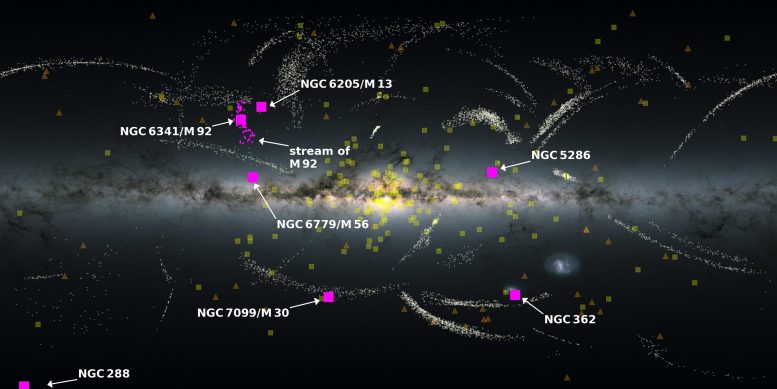
This image shows the Milky Way as seen by Gaia. The squares represent the location of globular clusters, the triangles the location of satellite galaxies, and the small dots are stellar streams. The dots and squares in purple are objects brought into the Milky Way by the Pontus merging galaxy. Credit: ESA/Gaia/DPAC, CC BY-SA 3.0 IGO
Our galaxy, the Milky Way, began forming around 12 billion years ago. Since then, it has been growing in both mass and size through a sequence of mergers with other galaxies.
Perhaps most exciting is that this process has not quite finished, and by using data from ESA’s Gaia spacecraft, astronomers can see it taking place. This in turn allows them to reconstruct the history of our galaxy, revealing the ‘family tree’ of smaller galaxies that have helped make the Milky Way what it is today.
The latest work on this subject comes from Khyati Malhan, a Humboldt Fellow at the Max-Planck-Institut für Astronomie, Heidelberg, Germany, and colleagues. Together, they have analyzed data based on Gaia’s early third data release (EDR3) looking for the remains of smaller galaxies merging with our own. These can be found in the so-called halo of the Milky Way, which surrounds the disc of younger stars and central bulge of older stars that comprise the more luminous parts of the Milky Way.
When a foreign galaxy falls into our own, great gravitational forces known as tidal forces pull it apart. If this process goes slowly, the stars from the merging galaxy will form a vast stellar stream that can be easily distinguished in the halo. If the process goes quickly, the merging galaxy’s stars will be more scattered throughout the halo and no clear signature will be visible.
But the merging galaxy may contain more than just stars. It could also be surrounded by a population of globular star cluster and small satellite galaxies. So, the team looked for these in the Gaia data.
In total they studied 170 globular clusters, 41 stellar streams, and 46 satellites of the Milky Way. Plotting them according to their energy and momentum revealed that 25 percent of these objects fall into six distinct groups. Each group is a merger taking place with the Milky Way. There was also a possible seventh merger in the data.
Five had been previously identified on surveys of stars. They are known as Sagittarius, Cetus, Gaia-Sausage/Enceladus, LMS-1/Wukong, and Arjuna/Sequoia/I’itoi. But the sixth was a newly identified merger event. The team called it Pontus, meaning the sea. In Greek mythology, Pontus is the name of one of the first children of Gaia, the Greek goddess of the Earth.
Based upon the way Pontus has been pulled apart by the Milky Way, Khyati and colleagues estimate that it probably fell into the Milky Way some eight to ten billion years ago. Four of the other five merger events likely also took place around this time as well. But the sixth event, Sagittarius, is more recent. It might have fallen into the Milky Way sometime in the last five to six billion years. As a result, the Milky Way has not yet been able to completely disrupt it.
Piece by piece, astronomers are fitting together the merger history of the Galaxy, and Gaia data is proving invaluable.
On 13 June 2022, the Gaia mission will issue its data release 3, which will provide even more detailed information about the Milky Way’s past, present, and future.
Reference: “The Global Dynamical Atlas of the Milky Way Mergers: Constraints from Gaia EDR3–based Orbits of Globular Clusters, Stellar Streams, and Satellite Galaxies” by Khyati Malhan, Rodrigo A. Ibata, Sanjib Sharma, Benoit Famaey, Michele Bellazzini, Raymond G. Carlberg, Richard D’Souza, Zhen Yuan, Nicolas F. Martin and Guillaume F. Thomas, 17 February 2022, The Astrophysical Journal.
DOI: 10.3847/1538-4357/ac4d2a

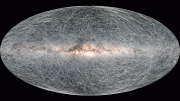
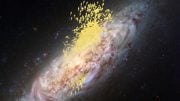
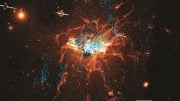

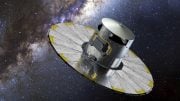
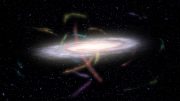
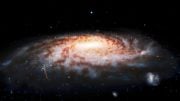
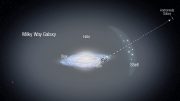
😏🤖👍learning learning ✨ learning